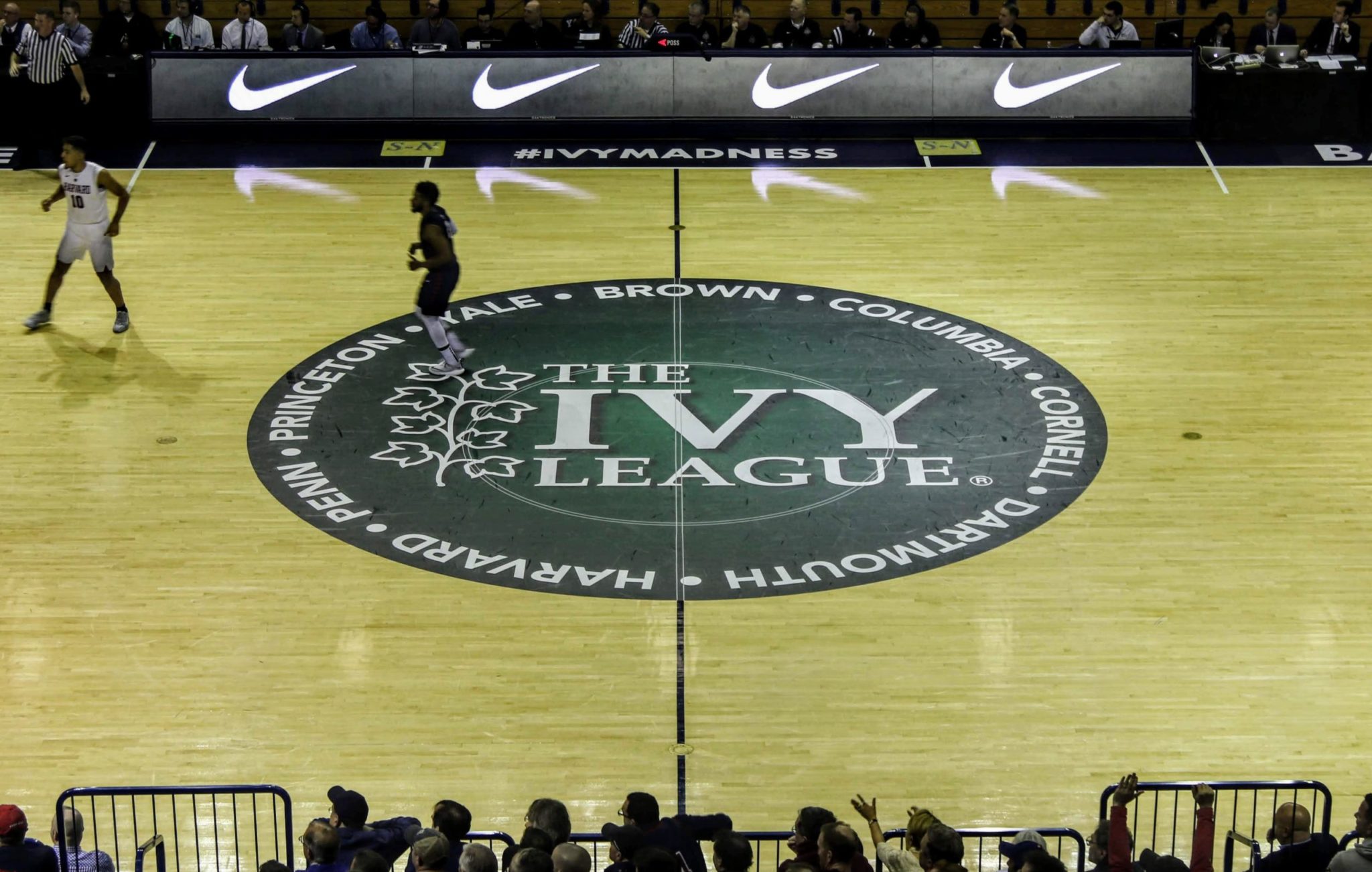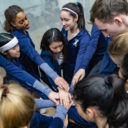How Ivy League SAAC presidents banded together to push for graduate eligibility exception
Rivals became teammates during a year with no competition, as all eight Ivy Student-Athlete Advisory Committees (SAACs) collaborated on a proposal for the Council of Presidents, collecting 1,500 student-athlete survey responses to build their case. The presidents ultimately agreed on a more limited waiver for graduating seniors.

William McCormack, Contributing Photographer
In an unprecedented fashion, on-field rivals became off-the-field allies, as the eight Ivy League Student-Athlete Advisory Committees worked together to fast-track their proposed graduate student exception policy to the Council of Presidents. The effort included a survey that canvassed conference student-athletes, collecting 1,500 responses, 97 percent of whom expressed support for allowing an exception for graduate eligibility due to the pandemic.
Earlier this month, Yale senior student-athletes received an email announcing that the Ivy League granted an exception to seniors across the Ancient Eight to compete as graduate students at their respective institutions, granted that they have been accepted into a degree-granting graduate program.
The decision evoked confusion and hope among Bulldog athletes who were mainly concerned about the timing of the announcement, which came after most graduate application deadlines at Yale had passed. But the announcement did not contain an explanation of how the change came to be. All eight Ivy SAACs came together to petition the Ivy League for a graduate student exception for all students — not just seniors — whose seasons were affected by COVID-19. Following the SAACs’ efforts, the Council of Presidents approved part of their petition, allowing the exception for senior student-athletes.
“We really were hoping that it would be … a blanket waiver for all student-athletes specifically because regardless of class year, we’ve all gone through this pandemic together,” Brown’s Ivy League SAAC representative Peri Sheinin said. “Although we were disappointed that it did not extend to all class years we took it … we were appreciative of the Ivy League’s willingness to reconsider their policy.”
In early December, shortly after hearing that the Ivy League had canceled the winter sports season, Cornell SAAC co-presidents Paul Casavant and Khary Pryce decided that they wanted to petition the Ivy League to allow all student-athletes who had lost seasons due to COVID-19 to compete as graduate students at their institutions.
Casavant and Pryce decided that their best plan of attack was to present a united front with the other SAACs to improve their chances of success.
“That’s what made this so special … it was one of the first times, I think the first time, since they adjusted practice times which was in like the ’80s or ’90s or something that the whole league, athletes across the league, came together to advocate for themselves,” Casavant said about working with the other Ivy League SAACs. “It was really just special to be a part of that and to be able to be a catalyst but then after [we] were the catalyst everyone really supported and took care of it.”
By the end of December, the SAAC presidents drafted a statement which they took to their respective athletic departments, student-athletes and fellow SAAC members, according to Penn’s SAAC president Yash Bhargava. After getting some input from their respective schools, the SAAC presidents finalized a draft and scheduled a meeting with Ivy League Executive Director Robin Harris on Jan. 14.
Harris helped the SAAC presidents revise some of the language in their letter and put it on the agenda for the next Council of Presidents meeting on Jan. 21, according to Casavant.
The normal process for instituting a policy change within the Ivy League is to petition the Ivy League’s Policy Committee, which reviews the proposed changes and sends their analysis to the Council of Presidents.
The SAAC Presidents were able to circumvent this process by banding together and getting Harris to present their proposal that all students affected by COVID-19 get the chance to play as graduate students directly to the Council of Presidents.
“At the meetings with the other Ivy SAACs, we drafted a letter to the Ivy presidents, discussed how this waiver would impact each school and took these ruminations back to our administration to discuss feasibility of the waiver at Yale,” Yale SAAC President Hannah Johns ’23 said. “Throughout this process, although the timing was not as early in the year as we had hoped, what encouraged us was the idea that if we could give additional opportunities to student-athletes across the Ivy League, we were going to do it.”
After the presidents saw the proposal, they sent it to the policy committee for a final review before making a ruling. The SAAC Presidents were advised by a member of the policy committee to compile a survey of what all student-athletes thought about the graduate exception for all affected students — to further build their case for a final meeting before the decision was made.
“The results were shocking,” Bhargava said. “We had around 1,500 student-athletes take that survey across the Ivy League. And it was around 82 percent who would utilize this opportunity, like 13 percent unsure and like only a few percent no. And then we asked another question: even if you are not utilizing this opportunity would you still support this decision? And that was 97 percent yes [for a fifth-year graduate competition exception] … we definitely had the student support even if they weren’t utilizing this opportunity. They were still willing to support it because that’s the right thing to do.”
Bhargava said that the Council of Presidents had scheduled a final meeting for Feb. 22 to discuss this change but that they were surprised with an email from Harris on Feb. 11 announcing that the Presidents had granted the exception to senior student-athletes. The Feb. 22 meeting did not take place.
Harris sent the email to SAAC Presidents around 30 minutes before other senior athletes were informed of the change by their respective athletic departments according to Cassavant.
“I think it was hinted at that [the Ivy League was] going to find some type of compromise,” Pryce said when asked whether they had been consulted on the final scope of the graduate student exception. “We were going to ask for a lot and they were going to give us a little. Our ask in the letter was a waiver for everybody … and that’s what we sent to the Council of Presidents. And then they bumped it down [to the Policy Committee.]”
Casavant said that the Ivy League was very helpful in allowing the proposal to skip through the process and get access to the Council of Presidents directly. Pryce added that the Ancient Eight conference would say that the process was fast given the bureaucracy involved in such a change.
But Casavant and Pryce agreed that the decision — however quickly the league might have moved — still felt late because the only group that was granted an exception would not be able to take full advantage of the opportunity due to the timing of the announcement.
The Ivy League referred the News to the statement that was sent to student-athletes regarding the Council’s decision.
“I submitted my application for Masters [on Feb. 25],” Bhargava said. “This is something that I obviously didn’t plan for but now that I have the option it definitely feels good. … I think if juniors would have gotten [the exception] it would have been so much better because they are the ones who have time to go through the process without being stressed. … Most of the seniors have no idea how to go through the process and most of the deadlines are already over … but seeing even two or three athletes take the opportunity I think that’s something that’s worth it and I’m proud of that.”
Without the exception, all athletes competing in the Ivy League must be undergraduates who use their eligibility over eight semesters of actual enrollment.
Eugenio Garza García | eugenio.garzagarcia@yale.edu








